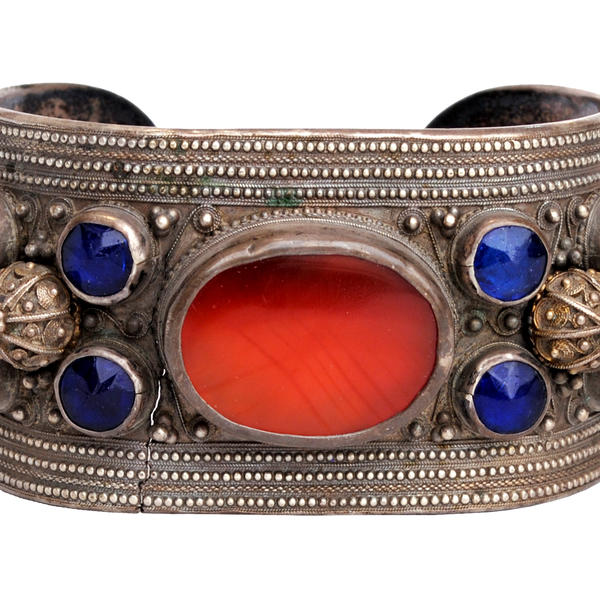The Avars are one of the indigenous ethnic groups living in the territory of Dagestan. Their craftsmen have been famous for their jewelry since ancient times. Almost every village had jewelers involved in silverwork making. They crafted rings, earrings and wrist wear for women, decorated housewares and weapons. In each district, silver items were designed in accordance with the local traditions.
Avarian bangle
Creation period
XIX - early XX century
Dimensions
19,5х3cm
Technique
Silver, gilding, carnelian, coloured glass, engraving, niello, filigree, granulation
Collection
Exhibition
3
Open in app#1
Avarian bangle
#2
#6
Pieces of jewelry were passed from generation to generation. Many of them were attributes of certain rites, for example, matchmaking (among women, it was widely discussed how many jewelry items a bridegroom presented to his bride, and what their quality was), and could tell a lot about the social status of their owner. They were decorated with niello patterns or filigree covering the item. Semi-precious stones and prominent coloured glass inserts were also used.
The collection of the Dagestan Museum includes a silver bangle with gilding; these have always been highly appreciated. It is decorated with coloured glass, several rows of granules and filigree (small silver spheres and strips of wire), as well as a carnelian stone - a scarlet mineral placed in the center and on the sides. Due to its shape, the bangle resembles bronze items found in Dagestan early medieval monuments of the VIII–X centuries.
The collection of the Dagestan Museum includes a silver bangle with gilding; these have always been highly appreciated. It is decorated with coloured glass, several rows of granules and filigree (small silver spheres and strips of wire), as well as a carnelian stone - a scarlet mineral placed in the center and on the sides. Due to its shape, the bangle resembles bronze items found in Dagestan early medieval monuments of the VIII–X centuries.
#3
Such bangles were an essential part of wedding jewelry sets as it was believed that beautiful things protected brides from the evil eye. Traditionally, if the mother of the groom was satisfied with the choice of her son, she put such a piece of jewelry on the girl’s arm early in the morning.
#4
The appearance of a bangle depended not only on the area in which it was created, but also on the age and social status of the woman wearing it. Girls mostly wore narrow twisted bangles, while married ladies had them wide and decorated with gemstones or coloured glass.
In the late XIX - early XX centuries, the Dagestan jewelry artwork became more eclectic. The jewelry ornamentation of this period differed from the traditional one, and included images and patterns of other ethnic groups. The prestige of silver jewelry among the women of Dagestan wavered in the 1980s when gold gradually replaced silver.
In the late XIX - early XX centuries, the Dagestan jewelry artwork became more eclectic. The jewelry ornamentation of this period differed from the traditional one, and included images and patterns of other ethnic groups. The prestige of silver jewelry among the women of Dagestan wavered in the 1980s when gold gradually replaced silver.
#7
P.S. Gamzatova Dagestan Museum of Fine Arts
read morehide
00:00
00:00
1x
Avarian bangle
Creation period
XIX - early XX century
Dimensions
19,5х3cm
Technique
Silver, gilding, carnelian, coloured glass, engraving, niello, filigree, granulation
Collection
Exhibition
3
Open in app
Share



